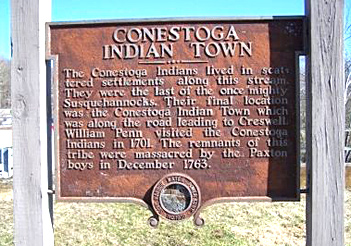How Conestogo Ontario Got Its Name – Part 1

The name Conestogo (or “Conestoga”) of our village in southwestern Ontario derives from a location in Lancaster County Pennsylvania located in the southeastern part of that state. This name was transplanted from Pennsylvania to the Waterloo region of Ontario because many of the original settlers of the Waterloo area came from Lancaster Country.
Conestoga in Pennsylvania was first called “Conestoga Manor” by William Penn, the original Governor of Pennsylvania, when he visited the area in 1701. At the time Conestoga Manor was near the site of an Indian village referred to as “Conestoga Indian Town” on the banks of the Susquehanna River where the remnants of the Conestoga Indian tribe lived until they were massacred in 1763.
Background to the massacre of the Conestoga Indians
The story of this massacre is interesting in its own right and demonstrates many of the political tensions that eventually led to the Revolutionary War two decades later, and the formation of many of the principles that would eventually be adopted by the new nation of the United States.
The territory of Pennsylvania was established in 1681 when William Penn, the leader of a growing group of Quakers from England, Germany, Scotland and Holland was given a sizable land grant west of New Jersey and the Delaware River. Penn became Governor of the new colony and the chief architect of both the new city of Philadelphia, and the laws and political principles that would govern the new territory.
Being something of a religious outcast in his own country Penn’s new colony was to be a haven for people of all religions. But typical of the conflict between religious freedom and moral uprightness that still exists in much of the U.S. today, “no one could vote or hold office unless he professed his belief in Jesus Christ as the Son of God and the Savior of the World.”
To his credit Penn infused the laws of the new colony with tolerance for differing religious viewpoints and his attitude towards American natives was generally a peaceable one. This attitude was broadly shared by the Quakers who ran the colony for its first 100 years. They preferred dealing with native Americans through treaties and negotiation rather than militarily.
In fact Penn spent a good deal of time, effort and money buying clear title to the land which he had been granted by the King of England. It was common practice in those early days to view the native inhabitants as the rightful title holders of the land. Therefore getting clear title involved making what were considered legally binding agreements with local native groups.
Similar negotiations had been going on for almost 100 years since the early settlements by the Dutch, Swedes and English. The most well known of these early deals was the purchase of Manhattan in 1626 when the Dutch paid the Lenape Indians 60 guilders for the island.
It is a widespread misconception that these early European settlers of North America viewed American natives as subhuman savages or “conquered peoples”. This is simply not true. For example, the Delaware people (Leni Lenape) who occupied the area around Philadelphia were never defeated militarily by the Dutch, Swedish or English.
There was no good reason to fight with them. Native tribes had been decimated by disease after initial contact, and they were generally quite willing to turn large chunks of their traditional homelands over to the whites in return for peaceful co-existence. Virtually from first contact Euro-immigrants and native Americans came to depend on each other for mutual cooperation and trade.
This arrangement between natives and whites held until the mid-1700s when the white population mushroomed, land became more scarce, and commerce between whites and natives became less important.
Land deals between Pennsylvania and the local Indians
More than half a century earlier William Penn himself negotiated with the Delaware and Susquehannock Indians and by 1701 had signed a treaty with both groups. This gave him access to lands along the Susquehanna River that had previously been claimed by New York State and their allies, the Iroquois Confederacy.
On the face of it this was an unusually “fair” arrangement with the Delawares and the Susquehannocks. With the 1701 treaty Penn had rewarded these tribes for their loyalty. After all, this agreement gave him the means to snatch these disputed lands from the clutches of New York and the Iroquois.
But the situation was complicated by the historical relationship between these local tribes and the Iroquois. For many years before and during the era of Euro-American occupation the Iroquois ran a virtual empire in which tribes like the Delaware and Susquehannocks had been subjugated by warfare.
Through defeat these tribes became part of what was known as the “covenant chain” which were forced to acknowledge the de facto overlordship of the Iroquois. This arrangement was similar in some respects to the one that exists between China and Tibet today.
As a result, the practical status of treaties signed between Penn and “covenant chain” tribes like the Delewares were open to inter-tribal disputes, and served as an excuse for the Iroquois to exercise their covenant chain rights.
This dispute with the Iroquois took a new turn in 1710 when William Penn’s successors signed a treaty at Conestoga making the Iroquois mediators in land disputes between local tribes and white Pennsylvania settlers. These new governors of Pennsylvania were primarily interested in getting access to the land previously pledged to the Delaware and Susquehannocks by William Penn in 1701. They knew the Iroquois would be willing to trade off the interests of their covenant chain partners for better trade opportunities with the rapidly expanding white settlers.
This is exactly what happened. By 1717 the Iroquois made deals with Pennsylvania Indian agents (including Benjamin Franklin) that allowed the state to seize Delaware land. Later in 1737 a new treaty was “discovered” by Thomas Penn (son of William) which ultimately pushed the Delaware into western Pennsylvania “refugee areas.” In both cases the Delaware disputed the deals but the Iroquois “mediators” decided in favour of the Pennsylvanians.
What happened to the Susquehannocks
By the middle of the 1700s the Conestoga Indians were a small tribe of fewer than 50 members living in the village of Conestoga on the banks of the Susquehanna River. They were what was left of the once much more significant and powerful Susquehannock nation. Where had the Susquehannocks gone?
In short, they were decimated by the Iroquois. Flash back approximately 100 years. In the early 1600s there were as many as 3000 Susquehannock warriors. At their peak in roughly 1608 they controlled the area on either side of the Susquehanna River and both sides of Chesapeake Bay. This was an extremely important trade route and gave the Susquehannocks a privileged position for trade with the rapidly expanding white population.
The Mohawks of the Iroquois Confederacy controlled the territory at the northern end of the Susquehanna River and they coveted the strategic location of the Susquehannocks and their access to trade with the British. As a result the Mohawks sent relentless raids down the river against the Susquehannocks and eventually reduced their numbers to about 550 by 1648. Eventually they were centered in the town of Conestoga and became known as the Conestogas.
Finally in 1675 the Iroquois overwhelmed the Conestogas and took over occupation of their village. The remaining Conestogas were enslaved and taken to live with the Oneidas (another member of the Iroquois Confederacy) until they lost their language. Some years later the few remaining Conestogas were allowed to return to their ancient village of Conestoga where they lived a peaceful life among the white settlers of the area.
The final massacre of the Conestogas
To get a sense of how and why the peaceful Conestogas were eventually brutally slaughtered by white settlers it is important to picture what was happening up and down the American Colonies in the 1700s. In the largely lawless lands just a few hundred miles to the west of the Atlantic seaboard hoards of European settlers were grabbing land wherever they could find it.
In many cases local Indians had signed treaties with the white governments in exchange for relocating from the seaboard areas to territory further inland. But towards the end of the 1600s and in the first decades of the 1700s a new breed of immigrant started arriving from Europe – mostly Scots and Irish who were dispossessed of their land through brutal suppression by absentee English landlords.
This was a belligerent and independent minded group who had little respect for English law. When they came to America they often had no taste for life in the new English towns near the coast. Instead they headed for the uncharted lands that had only a decade or two earlier been given by treaty to native tribes.
The result was an inevitable clash between the new settlers and the natives. What developed was “…a deep and implacable mutual hatred backed by some of the worst violence in the history of Indian-white relations.” (Page, 194) White settlers murdered natives with reckless abandon, and natives retaliated by raiding white homesteads and towns.
As a result, one particular group of Scots-Irish frontiersmen – the so-called Paxton Boys – took it upon themselves to cleanse their area of natives. They claimed the Pennsylvania government was protecting local Indians in a time of outright hostilities, and that local tax money was being spent on provisions for the natives.
Religion was also involved. The Paxton Boys were Presbyterians who viewed the natives as hostile heathens predestined to be stamped out by the elect. The leaders of Pennsylvania at the time were mostly Quaker pacifists who were unwilling to meet violence with violence.
Of course the Conestogas were not hostile to the local settlers. They had lived in peace with them since 1701, and, in any case by 1763 there were only 20 residents living in the town.
Nevertheless more than 50 Paxton Boys marched on the Conestoga village on December 14, 1763. They killed 6 members of the tribe and burned their cabins to the ground. The other 14 escaped.
The governor of Pennsylvania then took pity on the 14 refugees and placed them in protective custody in nearby Lancaster. A few days later the Paxton Boys overwhelmed the protectors. They killed and mutilated 6 adults and 8 children. Just two members of the tribe survived the massacre.
Some days later other colonials investigating the tragedy pulled the treaty of 1701 from the ashes of one of the cabins. This very treaty was signed by William Penn and pledged that the white settlers and natives “shall forever hereafter be as one Head & One Heart, & live in true Friendship & Amity as one People.” (Wikipedia – Paxton Boys)
The perpetrators of the massacre were convicted of homicide some time later. But no one ever came forward to identify a single member of the mob.
What does this have to do with Conestogo Ontario?
Now you may be wondering why the long-winded description of events in Pennsylvania. But the two villages in Pennsylvania and Ontario have more in common than the name. It was because of the loyalty to the British crown of the very Iroquois who drove the Conestogas to near extinction that the territory along the Grand River in Ontario was given to the Iroquois (under Joseph Brant).
It was also because of the squabbles in the American colonies between native tribes, French speaking fur traders, white settlers and absentee British authorities that native tribes like the Conestogas were driven to extinction and the United States was eventually formed.
And it was because of those revolutionary developments that the Iroquois of New York and many of the German speaking residents of Lancaster County Pennsylvania ended up in the Grand River area and created communities along that river like Waterloo, Kitchener, Brantford, Galt, and, of course, Conestogo.



